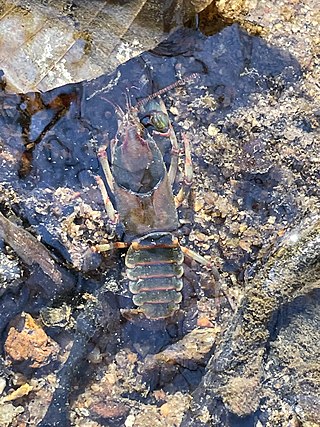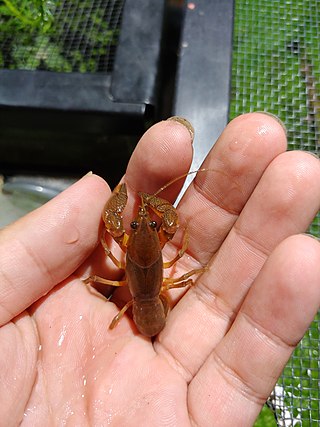
Cambarus is a large and diverse genus of crayfish from the United States and Canada. The adults range in size from about 5 cm (2.0 in) up to approximately 15 cm (5.9 in).
Cambarus catagius, the Greensboro burrowing crayfish, is a species of crayfish in the family Cambaridae. It is found only in a limited area of North Carolina, where it is considered a species of special conservation concern.
Cambarus chaugaensis, the Chauga crayfish or Chauga River crayfish, is a species of crayfish in the family Cambaridae. It is endemic to the Carolinas in the United States of America. The common and scientific names refer to the Chauga River of South Carolina, where the first specimens were collected.
Cambarus coosawattae, the Coosawattae crayfish, is a species of crayfish in the family Cambaridae. It is endemic to Georgia. The common name refers to the Coosawattee River, with the original specimens being collected in the Cartecay River which combines with another river to form the Coosawattee.
Cambarus harti, the Piedmont blue burrower, is a species of burrowing crayfish in the family Cambaridae. It is endemic to Georgia in the United States. The common name refers to the Piedmont plateau region.

Cambarus howardi, the Chattahoochee crayfish, is a species of crayfish in the family Cambaridae. It is found in North America. The common name refers to the Chattahoochee River, where the first specimens were collected.

Lacunicambarus miltus, the rusty gravedigger, is a species of crayfish in the family Cambaridae. It is found in the southeastern United States.

Cambarus scotti, the Chattooga River crayfish, is a species of crayfish in the family Cambaridae. It is endemic to Alabama and Georgia. The common name refers to the Chattooga River. The original specimens were collected from Clarks Creek in Chattooga County.
Cambarus truncatus, the Oconee burrowing crayfish, is a species of crayfish in the family Cambaridae. It is found in North America.
Distocambarus youngineri, the Newberry burrowing crayfish, is a species of crayfish in the family Cambaridae. It is endemic to South Carolina. The common name refers to Newberry county, where the original specimens were found.
Creaserinus danielae, the speckled burrowing crayfish, is a species of crayfish in the family Cambaridae. It is found in Mississippi, Alabama, Louisiana, and Florida.
Creaserinus gilpini, the Jefferson County crayfish, is a species of crayfish in the family Cambaridae. It is endemic to Arkansas.
Creaserinus gordoni, the Camp Shelby burrowing crayfish, is a species of crayfish in the family Cambaridae. It is endemic to Camp Shelby in Mississippi.
Fallicambarus harpi, the Ouachita burrowing crayfish, is a species of crayfish in the family Cambaridae. It is known only in southwest Arkansas. The species is a primary burrower, located in low lying seepage areas in pastures, yards and lawns.

Procambarus is a genus of crayfish in the family Cambaridae, all native to North and Central America. It includes a number of troglobitic species, and the marbled crayfish (marmorkrebs), which is parthenogenetic. Originally described as a subgenus for four species, it now contains around 161 species.

Fallicambarus is a genus of crayfish in the family Cambaridae from the United States and Canada. It includes 12 species, of which one is on the IUCN Red List as a vulnerable species (VU) and one as an endangered species (EN). The species of this genus are all restricted to three states or fewer, from Texas and Oklahoma east to Florida.

Lacunicambarus acanthura, the thornytail crayfish, is a species of crayfish in the family Cambaridae. It is found in the southeastern United States.

Faxonius is a genus of freshwater crayfish in the family Cambaridae. There are more than 90 described species in Faxonius. It includes the rusty crayfish, an invasive species in North America, and three species, F. virilis, F. immunis, and F. limosus, that are invasive to Europe.

Lacunicambarus is a genus of burrowing crayfishes in the family Cambaridae. There are currently 12 described species in Lacunicambarus, all of which are found east of the Continental Divide in North America. The genus was first recognized in 2018 when it was discovered through genetic analyses that the Cambarus subgenera Lacunicambarus and Tubericambarus were not monophyletic on their own, but that when combined they formed a single monophyletic group distinct from Cambarus. A 2022 study used anchored hybrid enrichment to resolve the Lacunicambarus phylogeny, which elucidated interspecific relationships and highlighted remaining undescribed diversity within the genus.

Samastacus is a genus of southern crayfish in the family Parastacidae. It has a single species, Samastacus spinifrons.









